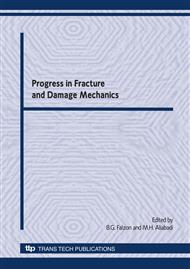[1]
Aliabadi, M.H. The Boundary Element Method. Applications in Solids and Structures. Vol. 2. John Wiley & Sons, Ltd, West Sussex, England (2002).
Google Scholar
[2]
Aliabadi M.H. A new generation of boundary element methods in fracture mechanics, International Journal of Fracture, 86, 91-125, (1997).
Google Scholar
[3]
Aliabadi M.H. Boundary element formulations in fracture mechanics, Appl. Mech. Review, 50, 83-96, (1997).
Google Scholar
[4]
Aliabadi M.H. and Portela,A. Dual boundary element incremental analysis of crack growth in rotating disc. Boundary Element Technology VII, Computational Mechanics Publications, Southampton, 607-616, (1992).
DOI: 10.1007/978-94-011-2872-8_41
Google Scholar
[5]
Bassani, J.L., and McClintock, F.A., Creep Relaxation of Stress Around a Crack tip, International Journal of Solids and Structures, 17, 479-492, (1981).
DOI: 10.1016/0020-7683(81)90055-x
Google Scholar
[6]
Becker, A.A., and Hyde, T.H., Fundamental Tests of Creep Behaviour, NAFEMS report R0027. (1993).
Google Scholar
[7]
Chao Y.J., Zhu, X.K., Zhang, L., Higher-Order Asymptotic Crack-Tip…elds in a power-law Creeping material, International Journal of Solids and Structures, 38, (2001).
DOI: 10.1016/s0020-7683(00)00255-9
Google Scholar
[8]
Cisilino, A.P. and Aliabadi, M.H., Three-dimensional BEM Analysis for Fatigue Crack Growth in Welded Components, International Journal for Pressure Vessel and Piping, 70, 135-144, (1997).
DOI: 10.1016/s0308-0161(96)00031-2
Google Scholar
[9]
Cisilino, A.P., Aliabadi, M.H. and Otegui, J.L., A Three-dimensional Element Formulation for the Elasto-Plastic analysis of Cracked Bodies, International Journal for Numerical Methods in Engineering, 42, 237-256, (1998).
DOI: 10.1002/(sici)1097-0207(19980530)42:2<237::aid-nme359>3.0.co;2-6
Google Scholar
[10]
Cisilino, A.P. and Aliabadi, M.H., Three-dimensional Boundary Element Analysis for Fatigue Crack in Linear and Non-Linear Fracture Problems, Engineering Fracture Mechanics, 63, 713-733, (1999). 12.
DOI: 10.1016/s0013-7944(99)00047-8
Google Scholar
[11]
Ehlers, R., and Riedel H., A Finite Element Analysis of Creep Deformation in a Specimen Containing a Microscopic Crack, in D. Francois(ed, ), Advances in Fracture Research, Proc. Fifth. Int. Conf. on Fracture, Vol 2, Pergamon, New York, pp.691-698, (1981).
Google Scholar
[12]
Hutchinson, J.W., Singular behaviour at the end of a tensile crack in a hardening material, J. Mech. Phys. Solids, 16, 13-31, (1968).
DOI: 10.1016/0022-5096(68)90014-8
Google Scholar
[13]
Leitao, V., Aliabadi, M.H., Rooke, D.P., The Dual Boundary Element Method for Elastoplastic Fracture Mechanics, Int. J. Num. Meth. Engng. (1994).
Google Scholar
[14]
Li, F.Z., Needlemen, A., Shih, C.F., Characterization of Near Tip Stress and deformation elds in creeping solids. International Journal of Fracture, 36, 163-186, (1988).
DOI: 10.1007/bf00035098
Google Scholar
[15]
Mendelson A., Boundary Integral Methods in Elasticity and Plasticity. Report No. NASA TN D-7418, NASA. (1973).
Google Scholar
[16]
Mi,Y. and Aliabadi M.H. Dual boundary element method for three-dimensional fracture mechanics analysis, Engng Anal. with Boundary Elem., 10, 161-171, (1992).
DOI: 10.1016/0955-7997(92)90047-b
Google Scholar
[17]
Oden, J.T., Finite Elements of Nonlinear Continua. McGraw-Hill, New York, (1972).
Google Scholar
[18]
Ohji, K., Ogura, Kubo, S., Stress-Strain…eld and modi…ed integral J-Integral the vecinity of a crack tip under transient creep conditions. Japanese Society of Mechanical Engineer, 790-13 18-20 (1979).
Google Scholar
[19]
Portela, A., Aliabadi, M.H., Rooke, D.P., The Dual Boundary Element Method: E¤ective Implementation for Crack Problems, Int. Journ. Num. Meth. Engng., 33, 1269-1287, (1992).
DOI: 10.1002/nme.1620330611
Google Scholar
[20]
Providakis, C.P., and Kourtakis, S.G., Time-dependent Creep Fracture Using Singular Boundary Elements, Computational Mechanics, 29, 298-306, (2002).
DOI: 10.1007/s00466-002-0342-y
Google Scholar
[21]
Riccardella, P. An Implementation of the Boundary Integral Technique for plane problems of Elasticity and Elastoplasticity, PhD Thesis, Carnegie Mellon University, Pitsburg, PA (1973).
Google Scholar
[22]
Rice, J.R., Rosengren, G.F., Plane Strain Deformation Near a Crack Tip in a Power Law Hardening Material, J. Mech. Phys. Solids, 16, 1-12, (1968).
DOI: 10.1016/0022-5096(68)90013-6
Google Scholar
[23]
Riedel,H., and Rice J.R. Tensil Cracks in Creeping Solids. Fracture Mechanics; 12th Congress, ASTM STP 700, American Society for Testing and Materials, pp.112-130, (1980).
Google Scholar
[24]
Swedlow, J. L. and Cruse, T. A. Formulation of the boundary integral equation for threedimensional elastoplastic ‡ow, International Journal of Solids and Structures, 7, 1673-1681 (1971).
Google Scholar
[25]
Telles, J. C. F., and Brebbia C.A. Elastic/viscoplastic Problems using Boundary Elements, International Journal of Mechanical Sciences, 24, 605-618, (1982). 13.
DOI: 10.1016/0020-7403(82)90004-2
Google Scholar


